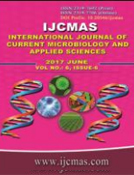


 National Academy of Agricultural Sciences (NAAS)
National Academy of Agricultural Sciences (NAAS)

|
PRINT ISSN : 2319-7692
Online ISSN : 2319-7706 Issues : 12 per year Publisher : Excellent Publishers Email : editorijcmas@gmail.com / submit@ijcmas.com Editor-in-chief: Dr.M.Prakash Index Copernicus ICV 2018: 95.39 NAAS RATING 2020: 5.38 |
Sunflower (Helianthus annus) is one of the important oil seed crops in India, which belongs to the family Asteraceae (Compositae). On the basis of cultural and morphological identification, 8 isolates of Sclerotium rolfsii were collected from different locations. Thus the present study was undertaken to know the pathogenicity and variability, so as to device better practices of the diseases to study cultural characteristic. In this study, eight isolates of stem rot were cultivated in Petri plates from sunflower, were established the following Kochs Postulates. The isolates were grown in PDA medium. Isolate SFSR1 in Petri plates recorded significantly maximum mycelial growth per day (31.45 mm) followed by SFSR3 and SFSR6. The isolate SFSR4 has recorded minimum mycelial growth per day (21.62 mm). In the production of sclerotia the isolate SFSR4 has produced significantly higher number of sclerotia (360 per plate) followed by SFSR1 (359.75), SFSR3 (324.25), SFSR6 (320.22), SFSR5 (290.68), SFSR2 (279.00) and SFSR8 (279.00). The isolate SFSR7 has produced minimum number of sclerotia (274 /plate). Among the isolates the biggest sclerotium (1224 mm) was produced by SFSR1 isolate followed by SFSR3 (1080 mm) and SFSR6 (1076 mm). The smallest sclerotium (1002 mm) was observed in SFSR8
 |
 |
 |
 |
 |